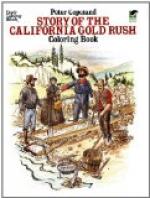ORCHARD, FARM, AND VINEYARD
Long ago the Mission Fathers taught the Indians to plant and to take care of vines and fruit-trees. They built water-works to bring life to the thirsty trees in the dry summers, and to grow oranges, limes, and figs, as well as peaches, apricots, and apples. They trained grape-vines over arbors and trellises round the Mission buildings, and from the small, black grapes made wine. Olive trees and date-palms did well at the southern settlements. But most of these orchards died when the Mission Fathers were no longer allowed to make the Indians work for the church property, though a few old palms and olive trees are still standing.
During Mexican days each ranch owner raised enough grain or corn and beans for his own family but planted no fruit, or but little, while the Americans who came to seek gold thought farming a slow way of making a living. People soon found out, however, that our fine climate and rich soil made good crops almost certain, and there was such demand for fruit and farm products that more and more acres were cultivated each year.
Our leading industry now is farming and fruit-growing, and California’s delicious fresh or cured fruit is sent all over the world. Large amounts of barley and hops are shipped from here to Europe, and our state produces almost all the Lima beans used in the country.
The citrus fruits, as oranges, lemons, and pomelos, or “grape-fruit,” are called, grow in the seven southern counties, or in the foothills on the western slope of the Sierras. The trees cannot endure frost and must be irrigated in the summer. Orange trees are a pretty sight, with their shining green leaves, white, sweet-smelling flowers, and the green or golden fruit. About Christmas-time, when oranges ripen, both blossoms and fruit may be picked from the same tree. Los Angeles and Orange County grow most oranges, but San Diego is first in lemon culture. Half a million trees in that county show the bright yellow fruit and fragrant blossoms every month in the year. The other southern counties also raise lemons by the car-load to send east, or for your lemonade and lemon pies at home.
[Illustration: An orange tree with fruit and blossoms.]
[Illustration: Palms over 100 years old at los Angles.]
There, too, the olive grows well, that little plum-shaped fruit you usually see as a green, salt pickle on the table. The Mission Fathers brought this tree first from Spain, where the poor people live upon black bread and olives. Olives are picked while green and put in a strong brine of salt and water to preserve them for eating. Dark purple ripe olives are also very good prepared the same way. Did you know that olive-oil is pressed out of ripe olives? The best oil comes from the first crushing, and the pulp is afterwards heated, when a second quality of oil is obtained. Olive trees grow very slowly, and do not fruit for seven years after they are planted. But they live a hundred years, and bear more olives every season.




